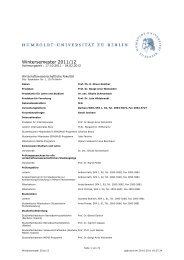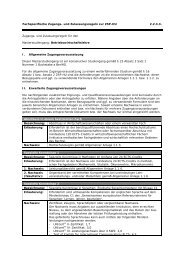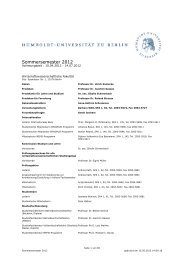Measuring the Effects of a Shock to Monetary Policy - Humboldt ...
Measuring the Effects of a Shock to Monetary Policy - Humboldt ...
Measuring the Effects of a Shock to Monetary Policy - Humboldt ...
You also want an ePaper? Increase the reach of your titles
YUMPU automatically turns print PDFs into web optimized ePapers that Google loves.
Bayesian FAVARs with Agnostic Identification 13<br />
procedures. S<strong>to</strong>ck and Watson [1989,1991,1991,2001,2003,2005], study a static version <strong>of</strong><br />
<strong>the</strong> DFM estimated via principal component analysis. In <strong>the</strong> proceeding papers <strong>the</strong>y<br />
consider a two-step estimation procedure. Forni,Hallin,Lippi and Reichlin (2001), provide<br />
a dynamic version <strong>of</strong> <strong>the</strong> PCA which is known as <strong>the</strong> generalized dynamic fac<strong>to</strong>r model<br />
(henceforth GDFM). Some refer <strong>to</strong> it also as <strong>the</strong> dynamic principal component analysis<br />
(DPCA) where <strong>the</strong> model is considered in <strong>the</strong> frequency domain. Kim and Nelson (1998),<br />
Otrok and Whiteman (1998) tackle <strong>the</strong> model estimation from a Bayesian perspective<br />
via Markov chain Monte Carlo (MCMC) simulation methods, in particular applying <strong>the</strong><br />
Gibbs sampler. This will be <strong>the</strong> approach I apply in my <strong>the</strong>sis in order <strong>to</strong> extract <strong>the</strong><br />
fac<strong>to</strong>rs and do inference on <strong>the</strong> models parameters. One <strong>of</strong> <strong>the</strong> most recent advances<br />
have been <strong>the</strong> so-called fac<strong>to</strong>r augmented vec<strong>to</strong>r au<strong>to</strong>regression (FAVAR) which has been<br />
introduced by Bernanke and Boivin [2003], and advanced in Bernanke, Boivin and Eliasz<br />
[2005], a framework in which <strong>the</strong> advantages <strong>of</strong> DFMs are combined with <strong>the</strong> analysis <strong>of</strong><br />
SVARs. The various model specifications and estimation procedures <strong>of</strong> large data sets on<br />
which <strong>the</strong> FAVAR builds are briefly explained in <strong>the</strong> following subsection where I provide<br />
an overview <strong>of</strong> <strong>the</strong> most important and influencing ones and briefly explain <strong>the</strong> different<br />
approaches.<br />
Dynamic fac<strong>to</strong>r models can be considered ei<strong>the</strong>r in <strong>the</strong> frequency domain representa-<br />
tion or in <strong>the</strong> state-space representation depending on <strong>the</strong> estimation approach desired.<br />
The model cast in <strong>the</strong> frequency domain representation are introduced and explained<br />
in several papers by Forni,Hallin,Lippi and Reichlin. They use an approximate DFM,<br />
and compute <strong>the</strong> eigenvec<strong>to</strong>r-eigenvalue decomposition <strong>of</strong> <strong>the</strong> spectral density matrix fre-<br />
quency by frequency and inverse-Fourier transform <strong>the</strong> eigenvec<strong>to</strong>rs <strong>to</strong> create polynomials<br />
in <strong>the</strong> lag opera<strong>to</strong>r which when applied <strong>to</strong> <strong>the</strong> observables, yields estimates <strong>of</strong> <strong>the</strong> dynamic<br />
principal components (DPCA).<br />
The latter is a generalization that captures all time series models, such as <strong>the</strong> au-<br />
<strong>to</strong>regressive integrated moving average model (ARIMA), and consists <strong>of</strong> one observation




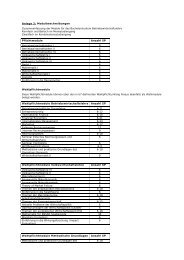

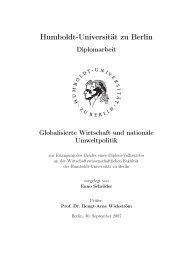
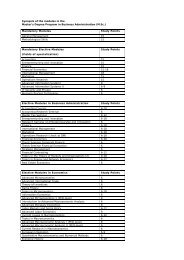
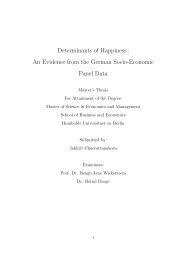
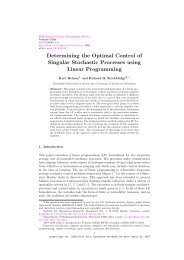
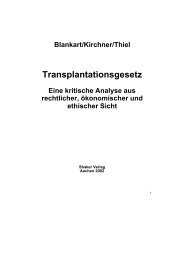
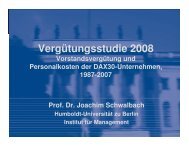

![[Text eingeben] [Text eingeben] Lebenslauf Anna-Maria Schneider](https://img.yumpu.com/16300391/1/184x260/text-eingeben-text-eingeben-lebenslauf-anna-maria-schneider.jpg?quality=85)

